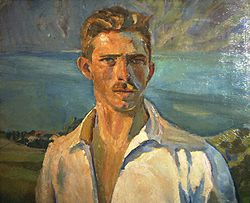Albert Weisgerber Prize for Fine Arts
The Albert Weisgerber Prize for Fine Arts is a recognition award from the city of St. Ingbert for the life's work of an artist.
The award was named after the artist Albert Weisgerber (1878–1915) , who was born in St. Ingbert . Since 1958 it has been awarded every three years; an award ceremony can also be waived. In the first decades it was conceived as an advancement award for young talents in the field of the fine arts, in the mid-1980s it was rededicated as a recognition award.
history
The Albert Weisgerber Art Prize , founded by the National Socialists, existed as early as 1935, and was immediately renamed the Westmark Prize in 1936 after the discovery that the artist's widow was Jewish and lived in exile in London . This prize, named after the planned Reichsgau Westmark, was awarded from 1937. In 1936 the prize was awarded to Albert Haueisen under the old name .
Guidelines
The award winners must be born in Saarland or in the neighboring cultural area or have their permanent residence (§ 3). Artists are understood as visual artists who work in the areas of painting, drawing, plastic design, graphics, photography, textile design, new media and action art (§ 4). The prize may not be divided (§ 5). The prize is awarded based on the decision of a jury of experts appointed by the city of St. Ingbert. The professional jury, which works on a voluntary basis, consists of at least 7 professional and lay judges. The specialist judges are at least four people who are professionally active in the cultural field, a former Albert Weisgerber award winner and two art experts from St. Ingbert citizens. The mayor, who has the presidency, the head of the cultural department, the head of the cultural office and one representative each of the political groups act as lay judges (§ 9). The prize is endowed with a total of 30,000 euros (2006), which is divided into prize money, the organization of an exhibition (with catalog) and the purchase of a work (§ 6). Applications for the award are not possible (Section 8). The official award ceremony takes place on May 10th, the anniversary of Albert Weisgerber's death, as part of a ceremony (§ 7).
The quorum is nine votes. “You are elected who has received more than half of the valid votes cast. If this majority is not achieved in the first or a second ballot, there will be a runoff among the two applicants who received the highest number of votes in the second ballot. In the event of a tie between several applicants, these applicants must be submitted to another runoff election. If the required qualified majority of the votes is not obtained here either, a further jury meeting will again discuss and vote on the candidates who were in the runoff election at the previous meeting. This procedure is repeated until a final majority is found ”(§ 10). The candidate proposals come from the ranks of the jury members, who can submit a confidential candidate proposal to the jury chairman up to six weeks before the first meeting (§ 11). (As of May 2015)
Award winners
- 1958 Jean Schuler (painter born January 15, 1912, † May 2, 1984)
- 1961 Max Mertz (painter, sculptor * January 13, 1912, † July 25, 1981)
- 1964 Fritz Berberich (painter, born August 30, 1909, † July 14, 1990)
- 1967 Leo Kornbrust (sculptor * 1929)
- 1970 Edvard Frank (painter * September 6, 1909, † July 24, 1972)
- 1973 Lothar Meßner (sculptor, graphic artist * December 13, 1926)
- 1976 Helmut Collmann (born August 6, 1918, † 1996)
- 1979 Volkmar Gross (painter born March 19, 1927, † October 19, 1992)
- 1982 Hans Schröder (sculptor, painter * July 28, 1930, † April 6, 2010)
- 1985 Jolande Lischke-Pfister (sculptor, graphic artist * July 29, 1932)
- 1988 Leo Erb (sculptor, painter * January 21, 1923, † October 21, 2012. He returned the prize, but not the 1991 prize money)
- 1991 Bettina van Haaren (painter * 1961)
- 1994 Oskar Holweck (painter, sculptor * November 19, 1924, † January 30, 2007)
- 1997 Lukas Kramer (painter * 1941)
- 2000 Paul Schneider (sculptor * May 5, 1927)
- 2003 Galli (* 1944)
- 2006 Werner Bauer (light and kinetic artist * 1934)
- 2009 Jo Enzweiler (pictorial artist, art educator * 1934)
- 2012 No prize was awarded this year
- 2015 Annegret Leiner (visual artist * 1941)
Individual evidence
- ^ Association of Palatinate Artists: Anniversary Exhibition 1922 - 1987, Kaiserslautern 1987, pp. 15, 16
- ^ Eva Habermehl: Albert Haueisen: (1872-1954); a south German painter and graphic artist; Studies of the work and catalog raisonné of the paintings. Heidelberg, Manutius-Verlag, 1998. ISBN 3-925678-76-X , note 588-590, p. 134
literature
- Kühr, Michael: Art in the focus of events. On the art history of the Saarland from Weisgerber to Berberich, 1909–1990. Mandelbachtal: Studio buk Verl. & Galerie, 2008. 282 p., Numerous. Ill. ISBN 978-3-00-023683-9
